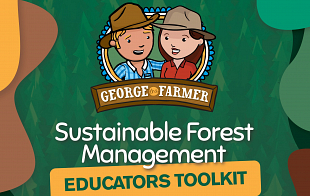George The Farmer – Sustainable Forest Management Educators Toolkit
Lesson Overview:
ForestLearning has joined with their good friends George The Farmer to produce this edition of Forestry Educators Toolkit for lower primary students.
Join George the Farmer as he explores and discovers more about were our timber comes from through practical hands-on classroom, or home learning, activities including:
ACTIVITIES:
- Where does our wood and paper products come from?
- Sustainable Development Goals
- Get into Advertising
- De Bono’s Six Hat Thinking exploring an issue from multiple viewpoints – how are plantation forests managed?
- The big school tree count!
- A changing climate
- Plant trees – get ready to get your hands dirty!
MULTIMEDIA LINKS:
Overview Videos:
GEORGE THE FARMER FORESTRY VIDEO:
GEORGE THE FARMER FORESTRY VR EXPERIENCE:
George the Farmer – In the Classroom Activity Videos:
How to use this Resource
This George the Farmer educational resource is intended as starting points for a cross-curricular approach to learning, based on the George the Farmer YouTube video “George the Farmer Forestry” and its accompanying Virtual Reality (VR) experience ‘George the Farmer Forestry VR’ on YouTube, or through ForestLearning’s website and ForestVR app.
Classes are encouraged to look at the video, the VR and read the lyrics to the song included in this resource. Follow up this guide with the George the Farmer Plantations Forests educators resource.
The activities seek to complement and extend the enjoyment students will experience from seeing the video and VR, whilst at the same time meeting some of the requirements of curriculum outcomes. The activities in this resource can be printed out for students, or alternatively, display the activity page from the PDF on your electronic white board and have the students use their existing workbooks to complete the task.
The activities in this resource can be printed out for students, or alternatively, display the activity page from the PDF on your interactive white board or import an activity page into your online teaching and learning environment such as Google Slides and have the students use their existing workbooks to complete the task.
Background
The forests of Australia serve many important purposes. They provide habitats for plants and animals and places for recreation, enjoyment, and culture.
Trees in forests help clean our water, protect our soils, and help fight climate change by capturing and storing carbon from the atmosphere in their wood. Productive sustainably managed forests provide us with renewable wood products (timber), paper (wood fibre), and other forest products like honey. It is important that forests are managed sustainably – for today and forever – to balance these competing demands.
AUSTRALIAN FORESTS – NOW AND FOREVER
A small area of Australia’s forests are used to produce a sustainable source of wood and wood fibre. They are like farms — every tree that is grown and harvested is again replaced with at least one more, just like a crop.
Year Level/s:
Key Curriculum Areas / Subject:
National Curriculum Codes:
Strand Content Description:
N/A
General Capabilities:
Cross Curriculum Priorities:
Curriculum Connections:
ScOT Catalogue Terms:
Theme/s:
Resource Type/s:
Primary:
Activity Pack
teacher Resource
George The Farmer - Sustainable Forest Management Educators Toolkit
The activities in this resource can be printed out for students, or alternatively, display the activity page from the PDF on your interactive white board or import an activity page into your online teaching and learning environment such as Google Slides and have the students use their existing workbooks to complete the task.
File Size: 6.57 MB
File Type: pdf
Login